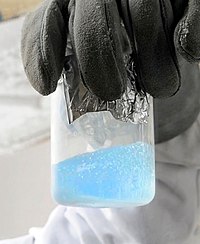
Photo from wikipedia
Abstract Ir and its oxide are the only available oxygen evolution reaction (OER) electrocatalysts with reasonably high activity and stability for commercial proton-exchange membrane electrolyzers. However, the establishment of structure–performance… Click to show full abstract
Abstract Ir and its oxide are the only available oxygen evolution reaction (OER) electrocatalysts with reasonably high activity and stability for commercial proton-exchange membrane electrolyzers. However, the establishment of structure–performance relationships for the design of better Ir-based electrocatalysts is hindered by their uncontrolled surface reconstruction during OER in acidic media. Herein, we monitor the structural evolution of two model Ir nanocrystals (one with a flat surface enclosed by (100) facets and the other with a concave surface containing numerous high-index planes) under acidic OER conditions. Operando X-ray absorption spectroscopy measurements reveal that the promotion of surface IrOx formation during the OER by the concave Ir surface with high-index planes results in a gradual OER activity increase, while a decrease in activity and limited oxide formation are observed for the flat Ir surface. After the activation process, the Ir concave surface exhibits ~ 10 times higher activity than the flat surface. Density functional theory computations reveal that Ir high-index surfaces are thermodynamically preferred for the adsorption of oxygen atoms and the formation of surface oxides under OER conditions. Thus, our work establishes a structure–performance relationship for Ir nanocrystals under operating conditions, providing new principles for the design of nanoscale OER electrocatalysts.
Journal Title: Applied Catalysis B: Environmental
Year Published: 2021
Link to full text (if available)
Share on Social Media: Sign Up to like & get
recommendations!